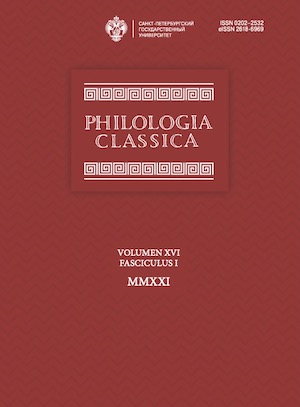Considerations on Two Cruces Philologorum (Ael. NA 15, 15)
DOI:
https://doi.org/10.21638/spbu20.2021.103Аннотация
The present article aims to elucidate an interesting narrative that forms a portion of Aelian’s paradoxographic work Περὶ ζῴων ἰδιότητος (On the Characteristics of Animals, Lat. De natura animalium). The passage under discussion describes some horned animals of oriental origin that were involved in the annual fighting contests during a one-day competition held on the initiative of a “great king of India” — probably Chandragupta (4th–3rd c. BC), the founder of the Maurya dynasty. Aelian’s chapter (NA 15, 15) was perhaps taken from Megasthenes’s Ἰνδικά (Description of India). The passage includes two hapax legomena referring to two species of animals: †μέσοι† and †ὕαιναι†. The first of these should be identified with the Ladakh urial (Ovis orientalis vignei Blyth); cf. Prasun məṣé ‘ram, urial’ (< Vedic mēṣá- m. ‘ram’). Aelian’s exact description of the horned animals called †ὕαιναι† clearly demonstrates that the alleged “striped hyena” (Gk. ὕαινα) must represent the chinkara, i. e., the Indian gazelle (Gazella bennettii Sykes). The Indo-Aryan term for ‘chinkara’ (Ved. hariṇá- m ‘Indian gazelle’, hariṇī́- f. ‘female gazelle’; cf. Pa. and Pk. hariṇa- m., hariṇī- f.) suggests that the corrupted form in Aelian’s passage should be emended as ὑάριναι [hyárinai]. This seems a near-optimal adaptation of the Pali or Prakrit appellative háriṇā pl. ‘chinkaras’.
Ключевые слова:
animal terminology, borrowings, etymology, Greek scientific literature, Greek vocabulary, hapax legomena, language contact, Middle Indo-Aryan languages
Скачивания
Библиографические ссылки
Загрузки
Опубликован
Как цитировать
Выпуск
Раздел
Лицензия
Статьи журнала «Philologia Classica» находятся в открытом доступе и распространяются в соответствии с условиями Лицензионного Договора с Санкт-Петербургским государственным университетом, который бесплатно предоставляет авторам неограниченное распространение и самостоятельное архивирование.






